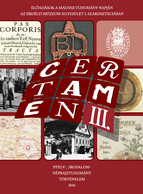Székely kopjafák új kontextusokban
Halberd Shaped Szekler Grave Posts in New Context
Author(s): Ferenc PozsonySubject(s): Anthropology
Published by: Erdélyi Múzeum-Egyesület
Keywords: symbol of death and grave; eastern heritage; death; transcendence; Hungarian symbol
Summary/Abstract: The Hungarian elite discovered the wooden headboard at the end of the 19th century. In the romantic period of the formation of the modern Hungarian nation and culture it was used to represent and to sustain the eastern origins of Hungarians and their culture. Therefore up to the end of the 19th century the wooden headboard had been referring to a certain person, to the decease of a concrete human being. Its basic meaning was related to death, loss of values, being a material item of culture with symbolic content, expressing in a more concentrated way the relation of a certain local community to transcendence and death. Thus it was suitable to transmit further symbolic messages in completely different and new locations and contexts. At the beginning of the 20th century we can find wooden headboards within the structure of secessionist buildings, book graphics, respectively literary works. After 1968 it appears on the grave of important Hungarian personalities, in public spaces, on memorial locations of historic events. Following the system change from 1989 wooden headboards – as material symbols of Hungarian historic memory – were placed in cemeteries, church yards, and public spaces. Meanwhile these items have gradually moved away from the graveyards, their basic function has changed, they have become outstanding, central elements of the festivities of local communities, on newly formed memorial places. They have become quite quickly universal Hungarian symbols; leaving their homeland, namely Szeklerland, they appear not only in Transylvania, but also in Hungary, in the Carpathian Basin, and all over the world, gaining new functions, specific, situational meanings. It is no accident, that a symbol of the grave, a symbol of death has gained an outstanding role in the structure of Hungarian commemorative festivities and community events.
Journal: Certamen
- Issue Year: 2016
- Issue No: III
- Page Range: 15-27
- Page Count: 13
- Language: Hungarian

